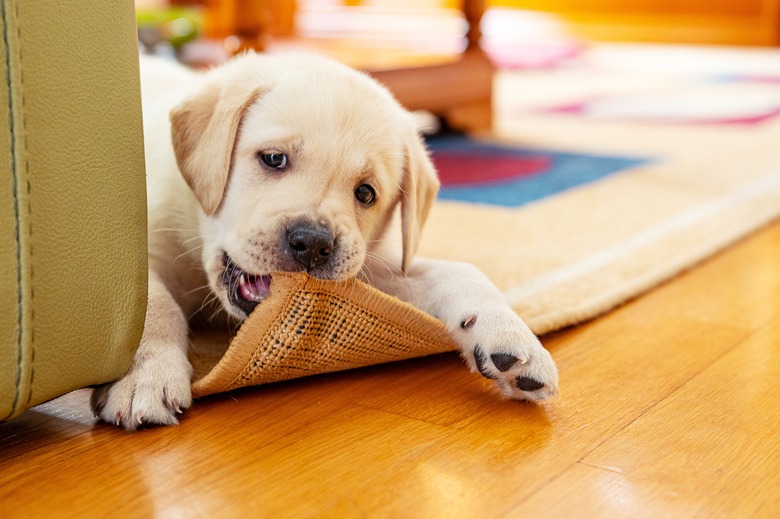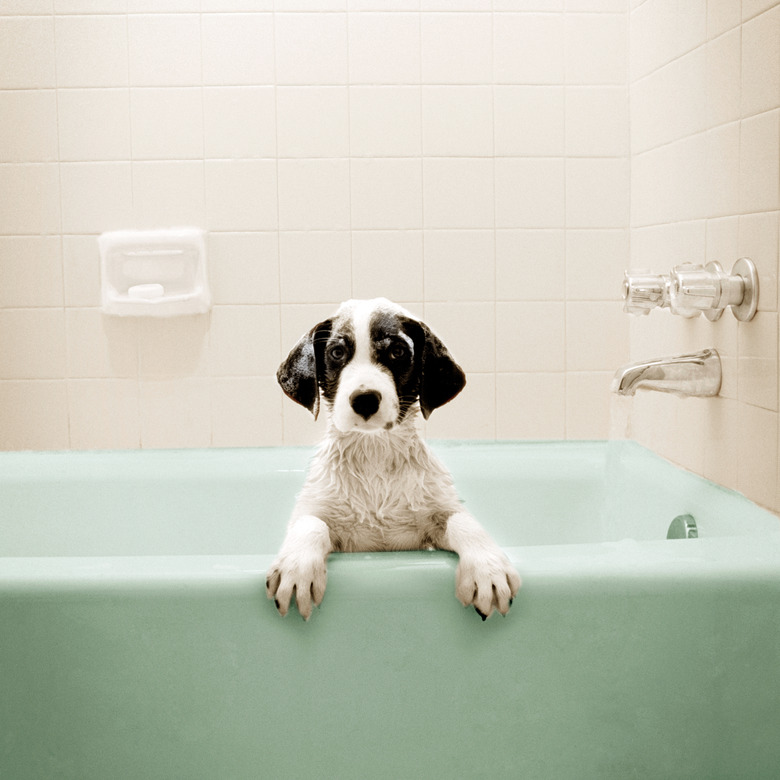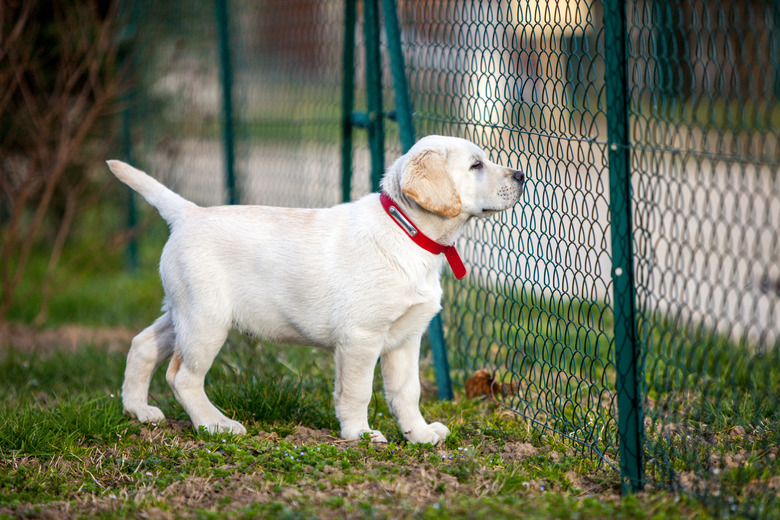Puppyproofing A House: A Room-By-Room Checklist
We may receive a commission on purchases made from links.
Much like a newborn, bringing a new puppy home is equal parts excitement and heavy preparation — and it pays to be prepared by fully puppyproofing your house before bringing your new family member into the mix. A proper puppyproof goes beyond simply laying out some newspapers to start house training and instead involves taking measures to ensure your highly energetic and incredibly new puppy is always safe in his new home. Your precocious pup is going to want to explore every inch of his new environment, and you'll find yourself surprised by what they might get into, especially when they are chewing on everything because they've started teething.
Whole-House Protections Against Chewing
Whole-House Protections Against Chewing
To discourage your new pet from chewing on furniture, flooring or other objects from day one, try using bitter apple spray. Put items on which puppies may be prone to chew (but shouldn't) in rooms, cupboards or closets that pups can't access. This includes shoes, crafting supplies, kids' toys and similar items. Go through your home and look for small items that could be choking hazards, such as coins, jewelry and rubber bands. Be sure to store these objects up high or in puppyproofed cabinets or drawers.
Unplug electrical cords throughout your home, as these are prime chewing targets for teething pups. Keep cords that must remain plugged in secured in cord covers and try to redirect your dog's chewing to something safe, like chew toys. Remember that dangling charging cords not only present electrocution and strangulation hazards but can also result in your devices falling, possibly breaking them and hurting the puppy.
To encourage your puppy to play with her toys, place a basket filled with things she can chew in the rooms where she spends the most time and frequently grab toys from the basket to play with her so she understands that's what to do when she gets frisky.
Look up all houseplants and the plants in your backyard to find out if they are toxic to dogs. Remove all toxic plants completely or store them in a closed room or on a high shelf where your pet can't reach them. For outdoor plants that can't be removed, you may try fencing in the plants.
Chemicals Safety for Dogs
Chemicals Safety for Dogs
Store dangerous chemicals, such as cleaning products, pesticides, car fluids, fertilizers and even soaps and shampoos, in places where he can't reach them. This could mean rooms the dog doesn't enter, like a basement, garage or shed, as well as childproofed cabinets or high shelves.
Because puppies also have a tendency to lick everything, use nontoxic cleaning products and pesticides or place your puppy in a dog crate or other safe space while you use the products and keep them out of an area until you are sure it is safe for her to reenter.
Puppyproofing Your Kitchen
Puppyproofing Your Kitchen
Dogs of all ages tend to love the kitchen because the smell of food is all around, but kitchens are home to dangerous appliances, choking hazards, dangerous utensils and poisonous foods. Many new dog owners assume that things locked in drawers and cabinets will be safe, but puppies may be able to pull these open, so install childproof latches. Also make sure to put food, appliances and utensils on high counters or in drawers where young puppies can't reach them.
Make sure you don't have any trash cans, chairs or step stools near the kitchen counter. If your pooch can get on the counter, he could eat foods that are toxic to him, knock items off the counter or step on the stove and burn himself or cause a fire. Also try to keep dining chairs pushed all the way in while not in use so your pup can't jump on the table.
Put your trash can under the sink or use a trash can with a lid so your pooch can't knock it over and get into dangerous trash, like chicken bones or moldy food scraps.
If you can't keep your new pup safe in your kitchen, use baby gates to close off the entry points to your kitchen. Place her food and water bowls in another room or let her only access the kitchen during mealtimes. If you do this, ensure your dog has access to water throughout the day.
Making Your Bathroom Safe
Making Your Bathroom Safe
Just like the kitchen, the bathroom presents quite a few dangers to your new puppy, and it's often best to try to keep your pooch out of the room altogether. After all, potty training a puppy takes place outside, not in the bathroom. If you do let the pup in the bathroom, keep your toilet lid closed to eliminate a drowning hazard for smaller dog breeds and a gross water source for larger pups.
Remember that toothbrushes, Q-tips, razor blades and other objects can present choking hazards to curious pups, so only use a bathroom trash can with a lid or store things in the bathroom cabinet.
Keep in mind that childproof caps on medicine and vitamin bottles will do nothing to slow down puppies, who open bottles by chewing them, not turning the lids, so always store these where puppies cannot reach them.
Living Room Puppy Safety
Living Room Puppy Safety
Overall, your living room should be the safest space for your pet, where you can leave her alone unsupervised. Some people will instead use a bedroom for this purpose. Whatever room is your puppy's safe space, spend extra time looking for choking hazards or things that could hurt your pooch if she chews on them.
Also, keep the doors closed in this room so your pooch can't escape. If you need to allow for more airflow, you can open the windows as long as they are too narrow for your pup to fit through. If your little pooch could push them open, leave them closed for his safety. If you have any dangling blind cords, make sure they're tied up high off the ground since these are a strangulation hazard.
Outside Safety for a New Puppy
Outside Safety for a New Puppy
Only let your pup outside without a leash if you have a fully secured fence — ideally, one that is tall enough that she won't be able to jump over it even as an adult dog. Also, never leave your pup unattended outside until you're sure she can't dig out and is too large to be threatened by local predators, such as hawks. Never let your pooch outside without his ID tag just in case he does manage to get loose.
Try to keep your yard well maintained. Fleas and ticks are more prevalent in long grasses. Dangerous wild creatures are more prone to hide in long grasses, and large bushes and some weeds, like foxtails, can be dangerous to pups.
If you keep your puppy's water and food bowls outside, empty them when not in use and clean them regularly because they can attract pests, and spoiled food and dirty water can cause your pet to get sick. Clean up your dog's feces immediately to reduce the risk of him eating it.
Remember that your pet is no better protected against extreme weather than you are. Even if you have a totally safe kennel outside with some shelter against rain and sun and even a comfortable dog bed, she will still be at risk of overheating in hot weather and at risk of freeze danger during cold weather.
Special Areas of Concern
Special Areas of Concern
When puppies are particularly young and small, stairs can present a fall risk, so install a baby gate at the top and bottom to keep your pup from using them when you're not around. When he gets big enough to use them on his own, remove the barricades.
If you have a pool, put a fence around it to prevent your dog from falling in accidentally and to stop your pooch from drinking the pool water, which could make her sick. You may also teach your pup to swim so she can get out safely in case she does mistakenly fall in.
References
- American Kennel Club: Puppy-Proofing Tips for Your Home And Yard
- Labrador Training HQ: Guide to Puppy Proofing Your Home And Garden
- Petco: Puppy-Proofing Your House
- Ruffle Snuffle: 10 Point Checklist to Puppy Proof Your House
- Canine Weekly: Puppy Proofing Your Home: A Checklist for First Time Puppy Owners


